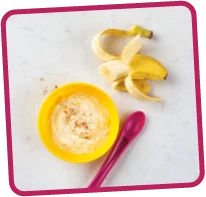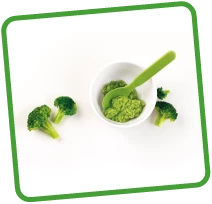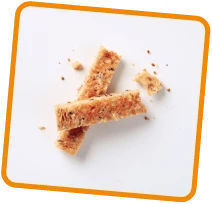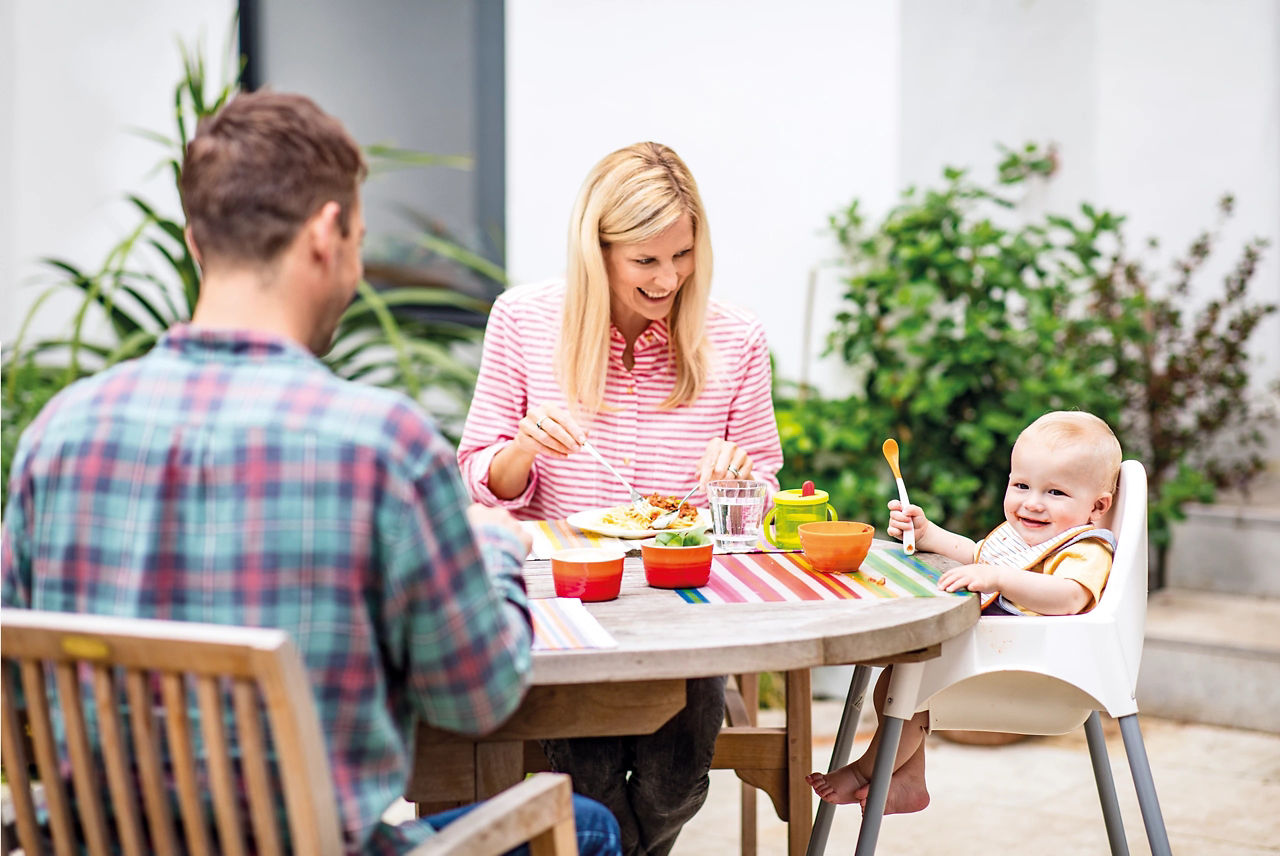From when to start weaning and what you’ll need to get going, we’re here to help make every step of your baby’s weaning adventure as easy as 1, 2, 3.
What's in this article
Get those baby spoons ready - it’s time to wean with C&G Baby Club.
Everything you need to know before you start
If your baby is showing the tell-tale signs that they’re ready to wean, there are a few things to consider before you roll up your sleeves and get stuck into the messy world of baby weaning.
Your baby’s first taste of solid food is an exciting and important milestone, and there are many ways to wean. From spoon-feeding new tastes and textures to letting your baby loose with the fun of finger foods and baby-led weaning, it’s all about learning what works for you and your baby.
Why is weaning important?
An essential (if messy) part of your little one’s development, there’s much more to weaning than you might think.
In the beginning, weaning is less about filling your baby up and more about1,2:
- Introducing your baby to new tastes - experimenting with different flavours to help avoid having a fussy eater on your hands.
- Getting them used to textures, like purees, lumpy and finger foods.
- Helping them learn how to move food around their mouth, chew, and swallow.
- Setting your little one up for a lifetime of healthy eating habits.
When to start weaning
It’s recommended that you wait until your baby is 6 months before you start weaning. This is because your baby will1:
- Get all the nutrients and energy they need up until that point from breast milk or formula milk.
- Cope better with solid foods.
- Be able to chew, swallow, and move food around their mouth better, helping your baby adjust quicker to different tastes and textures.
- Have more of the skills they need to feed themselves.
However, all babies are different, and it’s all about recognising the signs that tell you your baby is ready for solid foods. If you think your baby might be ready to wean before 6 months, have a chat with your healthcare professional and get their advice.

Signs your baby is ready to start weaning
There are 3 unmistakable signs that your little one is ready to wean. If your baby can1:
- Stay in a sitting position and hold their head steady.
- Pick food up to put it in their mouth.
- Swallow food and not spit it back out.
Then, chances are, it’s go-time!
Too soon for the spoon?
It can be all too easy to think your little one is ready to wean when they’re not. If your baby is3:
- Wanting more milk than usual.
- Waking more frequently in the night.
- Chewing their fists;
It may be that your baby is giving general feeding cues rather than signs that it’s time to start on solid foods.
Could it be a growth spurt?
Your baby will go through several growth spurts as they develop. They’ll usually last a few days and happen around 10 days, 2-3 and 4-5 weeks, and again at 3, 6, 9 and 12 months4.
If your baby becomes fussy and wants to feed more often, this could be a growth spurt. Give their appetite a little time to settle and keep feeding on demand. If you have any questions or concerns about how they’re feeding, chat with your healthcare professional.
Weaning equipment
Wondering what things you’ll need to get your weaning adventure started? Here are a few suggestions from C&G parents just like you.
Spoons
You'll need some baby-weaning spoons if you’re introducing your baby to those first tastes and textures using purees. “There’s so much choice out there when it comes to baby weaning equipment”, says George’s mum. “I chose weaning spoons that were quite soft, as these were gentler on his gums. I also went for short and chunky spoons that were easier to hold - which he insisted on doing!”
Ice-cube trays
Perfect for freezing first-time tastes of pureed fruits and veggies, ice cube trays are great for batch-cooking. A top tip from Seb’s mum: “If you can, invest in soft, flexible rubber ice cube trays. They make it so much easier to get your purees out.”
Beakers
Once your baby reaches 6 months, it’s a good idea to introduce them to a cup or a beaker rather than a bottle. Opt for a cup that is free-flow, as this will help your baby learn how to sip and will be better for their growing teeth5.
Hand blenders
A blender can make food prep easier, especially when making fruit and vegetable purees and experimenting with lumpier textures when your baby is ready.
Plastic bowls
Buy bowls made from a non-breakable material, just in case your baby drops them on the floor… “I soon discovered buying plastic bowls with a suction cup on the bottom was a good idea. My baby was so curious about the food, so anything that helped to keep it off the floor was a big help!”
Bibs
Weaning can be a messy business. At first, it may feel like your baby is getting more food on their clothes and the floor than in their mouth! Pelican bibs made from rubber or plastic protect your baby’s clothes. If your baby is taking the mess to new levels, try a full-sleeve bib - great for baby-led weaning.
The Essentials of Starting the Weaning Process
From tastes and textures to the foods to avoid, get in the know about those baby weaning essentials.
Tastes and textures
Variety is the spice of life when it comes to weaning, so offer your baby various tastes and flavours. Our top tip? Start your baby off with savoury flavours over sweet ones. This will help to avoid your baby having a preference. Cauliflower, carrot, green peas and pumpkin are all great options.
It’s also worth knowing that your baby may need to try something at least 10 times before they get used to it. Look out for those funny faces as your baby lets you know whether they’re puzzled by it, love it, or just plain old don’t like it!
As for textures, this all depends on how you choose to wean your baby. You will most likely start with purees, gradually moving onto more lumpy textures as your little one adapts. If you choose baby-led weaning, you may start with more lumpy textures and manageable soft finger foods.
Safety & Hygiene
Take a look at some essential top tips to help make the world of weaning healthy and safe for your little eater6:
- Never leave our baby alone when feeding.
- Chop small round foods before giving them to your baby - grapes and cherry tomatoes are good examples of food that needs to be cut before giving it to your baby. It’s also best to avoid giving your baby whole chunks of raw fruit and vegetables to minimise the risk of choking.
- Remove pips and stones from food.
- Ensure food is at the right temperature before giving it to your baby.
- Wash all fresh vegetables and fruit before cooking.
- Wash your hands, surfaces and any equipment you intend to use before you get started on your little one’s food prep.
- Throw away any food that your baby doesn’t eat.
- Don’t reheat cooked food more than once.
Vitamins for Babies
It’s natural to worry whether your baby is getting enough of the vitamins they need when they start weaning. However, the early stages of weaning are all about getting your baby used to new tastes and textures, and they’ll still get the nutrients and energy they need from breast milk or formula milk for a while.
If your baby is exclusively breastfed, they should be given between 8.5 and 10 mcg of vitamin D every day from birth and a supplement containing vitamins A and C from 6 months. If your baby is formula-fed, they’ll only need a vitamin supplement if they drink less than 500ml of formula daily, which usually happens when they’re about 12 months old7.
Food to Avoid while Weaning
To make sure your baby’s weaning diet is as healthy as it is tasty, some foods are best left off the baby weaning menu8:
- Sugar - avoid sugary treats and snacks; stick to plain water rather than juice.
- Salt - our baby’s kidneys aren’t yet ready to process salt, so avoid foods like bacon, ready meals and takeaway, crisps and salted chips. Avoid adding it to your cooking water or using stock cubes, too.
- Saturated fats - your baby doesn’t need biscuits and cakes. Avoiding them will help them get into healthy habits.
Read more about other foods to avoid when weaning, including honey, some cheeses, fish and seafood.
Ways to wean
Whether you choose purees, finger foods, baby-led weaning, or a little of everything, let’s explore the fun and tasty ways to wean.

Purées
Purees are a great way to introduce your baby to loving spoonfuls of new tastes and textures. Don’t be afraid to offer them more lumped and mashed foods between 6 and 7 months, as chewing and swallowing are skills they’ll need to learn9.

Soft finger foods
Offering your baby soft finger foods will allow them to feed themselves and explore how food looks, feels and tastes. Think soft broccoli florets and softly cooked carrot sticks.
Why not let your baby enjoy the best of both worlds and offer a few delicious finger foods alongside their purees?

Baby Led Weaning
Instead of feeding your baby mashed or pureed foods from a spoon, you might let them feed themselves with small pieces of finger foods right from the start. This is known as baby-led weaning9.
Whatever you decide, C&G mum Julia says, "Accept that you’re going to spend the first year doing a lot of cooking that, more often than not, will end up on the floor!"

How much milk should I give my baby during weaning?
Weaning babies will still get most of their energy and nutrients from milk - especially when they first start eating solid foods.
As your baby eats more, you’ll find that the amount of breast milk or formula milk that they drink decreases. From around 9 months, they’ll be drinking anywhere between 500-600ml of formula milk each day. If you’re breastfeeding, you can continue as you usually would, and you can continue for as long as you like10.
Read more about how much milk your baby needs when weaning.
How long does weaning take?
As well as how to wean your baby and when you might be asking yourself how long it will take for your weaning baby to get the hang of things.
Well, time flies when you’re having fun! As a general weaning guide, by 12 months, your little one will likely be enjoying three meals a day, along with a couple of healthy snacks in between1. Remember there are no hard and fast rules here - just go at your baby’s pace and follow their lead.
There’s new poo!
When you start to wean your baby, their poo is likely to change. It might become thicker, and darker in colour, and you may even see traces of food that has been eaten by your baby and come out again in their nappy. It will probably become stronger in smell (lucky you!), and your baby may also poo more or less than they did before11.
This is all completely normal, and is just a sign that their digestive system is starting to adapt to the addition of solid foods to their diet11.
- NHS. Your baby's first taste of solid foods [online 2022]. Available at https://www.nhs.uk/conditions/baby/weaning-and-feeding/babys-first-solid-foods/. [Accessed February 2025]
- Scientific Advisory Committee on Nutrition. Feeding in the First Year of Life. [Online 2018]. Available at: https://www.gov.uk/government/publications/feeding-in-the-first-year-of-life-sacn-report [Accessed February 2025]
- HSE. Starting your baby on solid foods [online 2022]. Available at https://www2.hse.ie/babies-children/weaning-eating/weaning/solid-foods/. [Accessed February 2025]
- NHS University Hospitals of Leicester. Feeding your baby [online]. Available at https://www.leicestershospitals.nhs.uk/aboutus/departments-services/maternity/leicester-maternity-services/after-the-birth/feeding-your-baby/#:~:text=Babies%20will%20have%20'growth%20spurts,9%20and%2012%20months%20old. [Accessed February 2025]
- NHS 111 Wales. Drinks and cups [online 2024]. Available at https://111.wales.nhs.uk/livewell/pregnancy/weaningdrinks/#:~:text=Introduce%20your%20baby%20to%20drinking,better%20for%20your%20baby's%20teeth. [Accessed February 2025]
- HSE. Weaning tips [online 2022]. Available at https://www2.hse.ie/babies-children/weaning-eating/weaning/tips/#:~:text=Always%20wash%20your%20hands%20before,and%20floor%20mats%20are%20useful. [Accessed February 2025]
- HSC Public Health Agency. Weaning made easy moving from milk to family meals [online]. Available at https://www.publichealth.hscni.net/sites/default/files/2019-03/Weaning_made_easy_nov%202018_0.pdf. [Accessed February 2025]
- NHS. Foods to avoid giving babies and young children [online 2022]. Available at https://www.nhs.uk/conditions/baby/weaning-and-feeding/foods-to-avoid-giving-babies-and-young-children/. [Accessed February 2025]
- NHS Start for Life. From around 6 months [online]. Available at https://www.nhs.uk/start-for-life/baby/weaning/what-to-feed-your-baby/from-around-6-months/#lumpy. [Accessed February 2025]
- NHS Midlands Partnership University. Moving onto solid foods [online]. Available at https://www.mpft.nhs.uk/services/infant-feeding-support/moving-solid-foods. [Accessed February 2025]
- babycentre. My baby's poo has changed now that they're on solids. Is this normal? [Online 2022]. Available at https://www.babycentre.co.uk/x1051573/my-babys-poo-has-changed-now-that-theyre-on-solids-is-this-normal. [Accessed February 2025]
Last reviewed: June 2025
Reviewed by Nutricia’s Medical and Scientific Affairs Team
Do not leave your little one unattended when eating and drinking
Need free advice with a smile? Get in touch with our dedicated Care team.
Ask us a question (8am - 8pm Mon-Fri, 10am - 5pm Weekends)
Messenger
Message us (10am-10pm Mon-Sat, 10am-5:30pm Sun)
Call Us
Call us on 0800 977 8880 (8am-8pm Mon-Fri, 10-5pm Sat)
FAQs
Get answers to your most frequently asked questions






